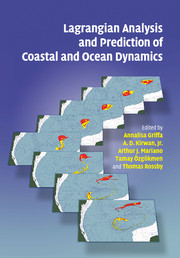Book contents
- Frontmatter
- Contents
- List of contributors
- Preface
- 1 Evolution of Lagrangian methods in oceanography
- 2 Measuring surface currents with Surface Velocity Program drifters: the instrument, its data, and some recent results
- 3 Favorite trajectories
- 4 Particle motion in a sea of eddies
- 5 Inertial particle dynamics on the rotating Earth
- 6 Predictability of Lagrangian motion in the upper ocean
- 7 Lagrangian data assimilation in ocean general circulation models
- 8 Dynamic consistency and Lagrangian data in oceanography: mapping, assimilation, and optimization schemes
- 9 Observing turbulence regimes and Lagrangian dispersal properties in the oceans
- 10 Lagrangian biophysical dynamics
- 11 Plankton: Lagrangian inhabitants of the sea
- 12 A Lagrangian stochastic model for the dynamics of a stage structured population. Application to a copepod population
- 13 Lagrangian analysis and prediction of coastal and ocean dynamics (LAPCOD)
- Index
- Plate section
- References
13 - Lagrangian analysis and prediction of coastal and ocean dynamics (LAPCOD)
Published online by Cambridge University Press: 07 September 2009
- Frontmatter
- Contents
- List of contributors
- Preface
- 1 Evolution of Lagrangian methods in oceanography
- 2 Measuring surface currents with Surface Velocity Program drifters: the instrument, its data, and some recent results
- 3 Favorite trajectories
- 4 Particle motion in a sea of eddies
- 5 Inertial particle dynamics on the rotating Earth
- 6 Predictability of Lagrangian motion in the upper ocean
- 7 Lagrangian data assimilation in ocean general circulation models
- 8 Dynamic consistency and Lagrangian data in oceanography: mapping, assimilation, and optimization schemes
- 9 Observing turbulence regimes and Lagrangian dispersal properties in the oceans
- 10 Lagrangian biophysical dynamics
- 11 Plankton: Lagrangian inhabitants of the sea
- 12 A Lagrangian stochastic model for the dynamics of a stage structured population. Application to a copepod population
- 13 Lagrangian analysis and prediction of coastal and ocean dynamics (LAPCOD)
- Index
- Plate section
- References
Summary
Introduction
It was during the 1999 Liege Colloquium on, “Three-Dimensional Ocean Circulation: Lagrangian measurements and diagnostic analyses,” that a number of researchers started to discuss the idea of having a meeting centered on studying the ocean, the atmosphere, and marine biology from a Lagrangian viewpoint. At the time of this writing, three Lagrangian Analysis and Prediction of Coastal and Ocean Dynamics (LAPCOD) meetings have been held in (i) Ischia, Italy from October 2–6, 2000, (ii) Key Largo, FL, USA from December 12–16, 2002, and (iii) Lerici, Italy from June 13–17, 2005. The LAPCOD meetings bring together a diverse group of scientists for the purpose of exchanging ideas on the collection, analysis, modeling, and assimilation of coastal and oceanic (quasi-)Lagrangian data. The purpose of this chapter is to provide both a tutorial for readers who are not specialists, and a summary of the material presented at the LAPCOD meetings and in this book. Since this chapter summarizes the material presented at LAPCOD meetings and because of space constraints, many important Lagrangian-based studies are not detailed here and the chapter topics, listed in the next paragraph, are those topics that have been central to the LAPCOD meetings and this book. There are a number of unpublished results presented at LAPCOD 2005 discussed here and referenced by personal communication, hereafter pers. com.
- Type
- Chapter
- Information
- Lagrangian Analysis and Prediction of Coastal and Ocean Dynamics , pp. 423 - 479Publisher: Cambridge University PressPrint publication year: 2007
References
- 2
- Cited by

